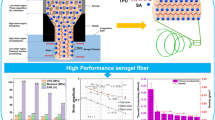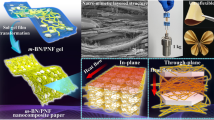Abstract
The zinc ion is used as a catalyst to effectively replace the traditional copper ion catalyst to participate in the redox reaction of hydrazine hydrate and hydrogen peroxide to generate diimide to selectively hydrogenate the carbon–carbon double bonds in the nitrile butadiene rubber (NBR) latex to prepare hydrogenated NBR (HNBR). The optimized zinc ion catalytic hydrogenation system was obtained through orthogonal design experiment screening. Among them, the hydrogenation of NBR latex with zinc chloride as a catalyst can obtain HNBR-ZnCl2 products with high hydrogenation degree (90.58%), high thermal stability, and high regularity. Using zinc ions as a catalyst instead of copper ions can effectively improve the damage of copper ions remaining in the hydrogenated product on the thermal-oxidative aging resistance performance of rubber. Compared with HNBR hydrogenated by copper ions, HNBR hydrogenated by zinc ion catalysts has better thermal-oxidative aging resistance performance.
Graphical abstract

















Similar content being viewed by others
References
Promchim J, Kanking S, Niltui P, Wimolmala E, Sombatsompop N (2016) Swelling and mechanical properties of (acrylonitrile-butadiene rubber)/(hydrogenated acrylonitrile-butadiene rubber) blends with precipitated silica filled in gasohol fuels. J Vinyl Add Tech 22:239–246
Choudhury A, Bhowmick AK, Ong C, Soddemann M (2010) Influence of molecular parameters on thermal, mechanical, and dynamic mechanical properties of hydrogenated nitrile rubber and its nanocomposites. Polym Eng Sci 50:1389–1399
Choudhury A, Bhowmick AK, Ong C (2009) Effect of different nanoparticles on thermal, mechanical and dynamic mechanical properties of hydrogenated nitrile butadiene rubber nanocomposites. J Appl Polym Sci 116:1428–1441
Bhattacharjee N, Bhowmick AK, Avasthi BN (1990) Hydrogenation of nitrile rubber using a new homogeneous palladium (II) catalyst: synthesis and characterization. J Appl Polym Sci 41(6):1357–1363
Schulz GAS, Comin E, de Souza RF (2007) Catalytic hydrogenation of nitrile rubber using palladium and ruthenium complexes. J Appl Polym Sci 106(1):659–663
Tangthongkul R, Prasassarakich P, McManus NT, Rempel GL (2004) Hydrogenation of cis-1,4-polyisoprene catalyzed by Ru(CHCH(Ph))Cl(CO)(PCy3)2. J Appl Polym Sci 91(5):3259–3273
Chen J, Ma L, Cheng TT, Cai AF, Hu YD, Wu ZJ, Liu HY, Bao XJ, Yuan P (2018) Stable and recyclable Pd catalyst supported on modified silica hollow microspheres with macroporous shells for enhanced catalytic hydrogenation of NBR. J Mater Sci 53(21):15064–15080
Zhang P, Zhang HW, Wang SH, Lei XQ, Yang JT, Li ZM, Zhu HB, Bao XJ, Yuan P (2020) Effect of support morphology on the activity and reusability of Pd/SiO2 for NBR hydrogenation. J Mater Sci 55(27):12876–12883
Chen J, Wu ZJ, Liu HY, Bao XJ, Yuan P (2019) A Surface-cofunctionalized silica supported palladium catalyst for selective hydrogenation of nitrile butadiene rubber with enhanced catalytic activity and recycling performance. Ind Eng Chem Res 58(27):11821–11830
Ge BQ, Hua YD, Zhang HW, Xu JK, Zhang P, Yue YY, Zhu HB, Lin S, Yuan P (2021) Zirconium promoter effect on catalytic activity of Pd based catalysts for heterogeneous hydrogenation of nitrile butadiene rubber. Appl Surf Sci 539:148212–148219
Wideman LG (1984) Process for hydrogenation of carbon-carbon double bonds in an unsaturated polymer in latex form. US Patent 4452950
Singha NK, Bhattacharjee S, Sivaram S (1997) Hydrogenation of diene elastomers, their properties and applications: a critical review. Rubber Chem Technol 70:309–367
Brück D (1989) IR spectrometric determination of the proportions of acrylonitrile, butadiene and hydrogenated butadiene in hydrogenated acrylonitrile-butadiene rubbers. Part 1. Principles. KGK-KAUT GUMMI KUNST 42:107–110
Brück D (1989) IR spectrometric determination of the proportions of acrylonitrile, butadiene and hydrogenated butadiene in hydrogenated acrylonitrile-butadiene rubbers. Part 2. Residual double bonds in commercial HNBR products. KGK-KAUT GUMMI KUNST 42:194–197
Wang H, Yang LJ, Rempel GL (2013) Homogeneous hydrogenation art of nitrile butadiene rubber: a review. Polym Rev 53(2):192–239
Mou H, Shen F, Cao Y et al (2008) Study on the non-liquid-phase coordination crosslinking reaction of acrylonitrile-butadiene rubber/copper sulfate composites. Acta polymerica sinica 9:910–913
Mou H, Shen F, Shi Q et al (2012) A novel nitrile butadiene rubber/zinc chloride composite: coordination reaction and miscibility. Eur Polymer J 48(4):857–865
Mou H, Xue P, Shi Q et al (2012) A direct method for the vulcanization of acrylate rubber through in situ coordination crosslinking. Polym J 44(10):1064–1069
Ou HM, Wang Y, Zhou W et al (2016) Kinetics investigation on the hydrogenation of acrylonitrile-butadiene rubber latex by using new catalytic reaction system. Catal Commun 84:183–187
Li SY (2005) Studies on gel mechanism and hydrogenation process of nitrile rubber latex. Bei**g university of chemical technology 1–53
Aylward F, Sawistowska MH (1962) Reductions with diimide. Chemical Industry (London) 484
Parker DK, Roberts RF, Schiessl HW (1992) A new process for the preparation of highly saturated nitrile rubber in latex form. Rubber Chem Technol 65:245–258
Xue JH (2019) Study on isobutene oligomerization over supported zinc sulfate catalyst. Dalian university of technology 1–60
Zhou SQ, Li SY, Bai HD (2006) Study on crosslinking in diimide reduction of nitrile butadiene rubber. Rubber Chem Technol 79(4):602–609
Severe G, White JL (2002) Transition behavior of hydrogenated acrylonitrile-butadiene rubber. KGK-KAUT GUMMI KUNST 55:144–148
Arsenault G, Brown T, Jobe I (1994) An approach to modern polymer development: enhancement of the service temperature range for hydrogenated nitrile-butadiene rubber (HNBR). 145th Meeting of the Rubber Division, ACS, Chicago, IL
Kobatake T, Kodama K, Hayashi S, Yoshioka A (1997) Improvement of low-temperature flexibility of hydrogenated nitrile-butadiene rubber. Rubber Chem Technol 70:839–854
Yang QZ (2004) Modern rubber technology. Sinopec Publishing, Bei**g, pp 1–685
Funding
This work was supported by a grant (code no. 2018JMRH0205) from high performance of hydrogenated nitrile butadiene rubber prepared by new technology funded by the key research and development project of Shandong province, China.
Author information
Authors and Affiliations
Contributions
All authors have given approval to the final version of the manuscript.
Corresponding authors
Ethics declarations
Conflict of interest
The authors declare no competing interests.
Additional information
Publisher's Note
Springer Nature remains neutral with regard to jurisdictional claims in published maps and institutional affiliations.
Rights and permissions
About this article
Cite this article
Wang, X., Sun, J., Wang, C. et al. Diimide hydrogenation of NBR latex using different zinc ions catalytic system. Colloid Polym Sci 300, 661–674 (2022). https://doi.org/10.1007/s00396-022-04962-6
Received:
Revised:
Accepted:
Published:
Issue Date:
DOI: https://doi.org/10.1007/s00396-022-04962-6




